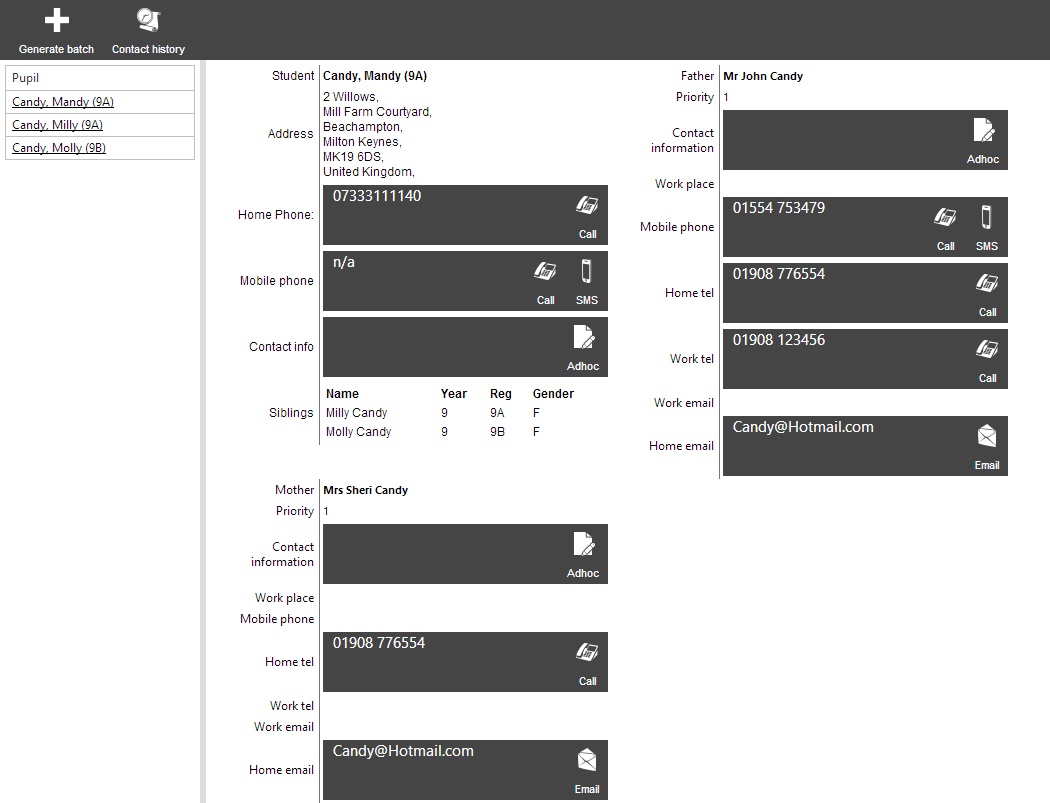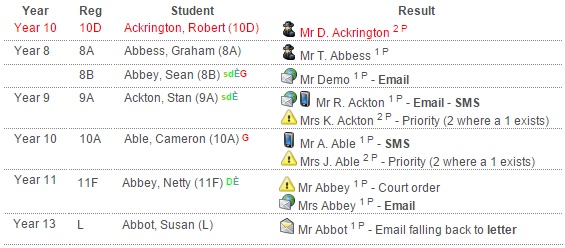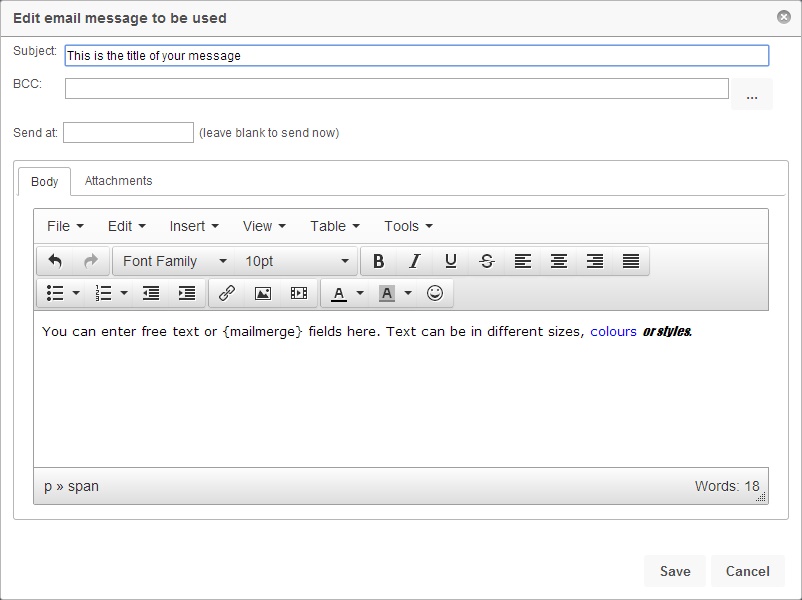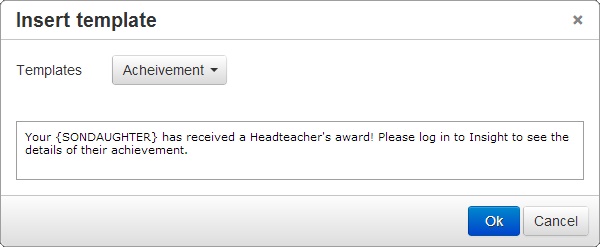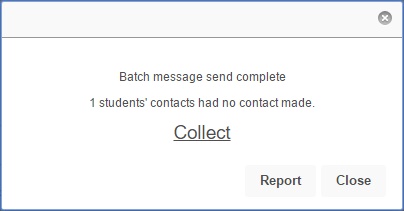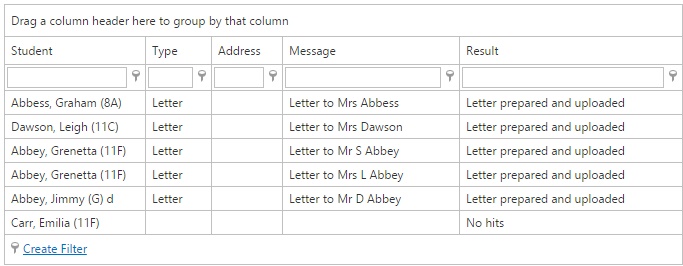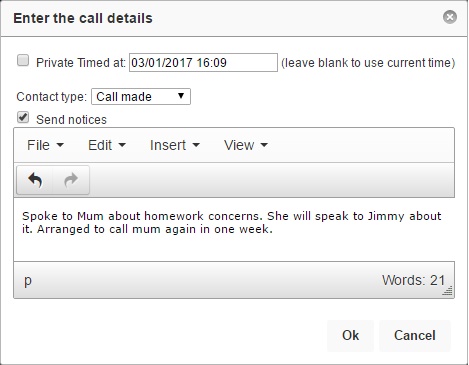Difference between revisions of "External contact"
| Line 13: | Line 13: | ||
==Sending letters, emails or SMS messages== | ==Sending letters, emails or SMS messages== | ||
| − | The most common use for this page is sending messages home to parents. | + | The most common use for this page is sending messages home to parents. The first step is to click the Generate batch button at the top left of the page. <br> <br> |
| − | === | + | ===Stage 1: Recipients=== |
| − | + | There are three tabs or stages, which must be worked through in order. The first stage is used to select the recipients to send the message to, and the method to use when sending the messages. <br> <br> | |
| − | + | The left side of the page shows the students that have been selected. Students can be deselected here, if they or their contacts are not to receive the message. <br> <br> | |
| − | [[ | + | The middle of the page is used to select the recipients of the message. There is a [[preferences|preference#External contact]] (Use priority 1 contacts only) that affects these options. If the preference is on, the middle two options will begin with "Priority 1". If the preference is off then the middle two options will begin with "Highest priority". <br> <br> |
| − | + | {| | |
| − | : | + | |[[Image:EXC_p1.jpg]]||[[Image:EXC_highestP.jpg]] |
| + | |- | ||
| + | |With the preference on||With the preference off | ||
| + | |} <br> | ||
| − | + | The right side of the page shows the methods that can be used to send messages. If a fallback method is selected, the second method of contact will only be used if the first is unavailable e.g. if "SMS falling back to Email" is selected, contacts will only receive an email if they do not have a valid SMS number. <br> <br> | |
| − | |||
| − | + | ===Stage 2: Identify=== | |
| − | : | ||
| − | + | The second tab will identify the contacts who are going to receive messages, and which method will be used to contact them. <br> <br> | |
| − | |||
| − | [[Image: | + | [[Image:exc_identify.jpg]] <br> <br> |
| − | ' | + | Any students who cannot be contacted using the options selected will appear at the top of the list highlighted in red. Next to each student's name will be a list of contacts that PARS considered sending the message to. Each contact will have a number next to their name and may also have the letter "P". The number indicates the priority of the contact, and if the letter "P" is displayed then the contact has Parental Responsibility for that child. <br> <br> |
| − | |||
| − | + | [[Image:exc_PP.jpg]] <br> <br> | |
| − | : | ||
| − | + | There will also be icons next to each contact giving further information about how the contact is going to receive the message, or why they are not going to be contacted. The possible icons are: <br> <br> | |
| − | |||
| − | [[Image: | + | {| |
| + | !Icon!!Meaning | ||
| + | |- | ||
| + | |[[Image:sms.jpg]]||The contact is going to receive an SMS | ||
| + | |- | ||
| + | |[[Image:emailicon.jpg]]||The contact is going to receive an email | ||
| + | |- | ||
| + | |[[Image:letter.jpg]]||The contact is going to receive a letter | ||
| + | |- | ||
| + | |[[Image:warning.jpg]]||The contact will not receive a message because they either have a court order, or their priority level is too low | ||
| + | |- | ||
| + | |[[Image:spy.jpg]]||The contact will not receive a message because they do not have any valid contact details | ||
| + | |} <br> | ||
| − | + | ===Stage 3: Documents=== | |
| − | |||
| − | : | ||
| − | + | The next step is to choose the message that will be sent. There will be buttons to create a message for SMS, email or letter depending on how the messages are going to be sent. <br> <br> | |
| − | |||
| − | + | When any of the buttons are clicked, a text editor will open to compose the message. free text can be entered into the editor, as well as mail merge fields or messages imported from the [[message bank]]. <br> <br> | |
| − | |||
| − | |||
| − | |||
| − | |||
| − | |||
| − | |||
| − | |||
| − | |||
| − | |||
| − | |||
| − | |||
| − | |||
| − | |||
| − | |||
| − | |||
| − | |||
| − | |||
| − | |||
| − | |||
| − | |||
| − | |||
| − | |||
| − | |||
| − | |||
| − | |||
| − | |||
| − | |||
| − | |||
| − | |||
| − | |||
| − | |||
| − | |||
| − | |||
| − | |||
| − | |||
| − | |||
| − | |||
| − | |||
| − | |||
| − | |||
| − | |||
| − | |||
| − | |||
| − | |||
| − | |||
| − | |||
| − | |||
| − | |||
| − | |||
| − | |||
| − | |||
[[Image:excon3.jpg]] <br> <br> | [[Image:excon3.jpg]] <br> <br> | ||
| − | + | Mail merge fields are inserted by clicking the "Insert" button and then "Field" - a list of the available merge fields will be displayed. Messages can also be imported from the message bank by clicking "Insert" then "Insert template". The drop-down at the top of the window is used to select different messages. <br> <br> | |
[[Image:exconmsgbank.jpg]] <br> <br> | [[Image:exconmsgbank.jpg]] <br> <br> | ||
| − | |||
| − | |||
Finally, click the "Generate" button at the top right of the page to send your message! <br> <br> | Finally, click the "Generate" button at the top right of the page to send your message! <br> <br> | ||
Revision as of 15:18, 1 December 2015
| Permissions required to access this module: | |
| Section: | |
| Contact management | |
| Permission(s): | |
| Access notices management screen | |
| Manage and review external communications | |
The external contact page is used to send messages home to parents or pupils. It can also be used to record phone calls or the details of meetings with parents. You can also see a log of all communications between the school and the pupil's family at the bottom of the page.
You may need to configure SMS in PARS, as well as configuring your preferences to allow emails to be sent. This can usually be done by your network manager.
Contents
The External Contact page
The external contact page is shown below. The list of pupils being used by this page are shown on the left. You can click on a pupil to select them, which will update the rest of the page. The rest of the page will show you the pupil's own details i.e. the pupil's email address or the pupil's mobile number as well as their parents' details.
Sending letters, emails or SMS messages
The most common use for this page is sending messages home to parents. The first step is to click the Generate batch button at the top left of the page.
Stage 1: Recipients
There are three tabs or stages, which must be worked through in order. The first stage is used to select the recipients to send the message to, and the method to use when sending the messages.
The left side of the page shows the students that have been selected. Students can be deselected here, if they or their contacts are not to receive the message.
The middle of the page is used to select the recipients of the message. There is a preference#External contact (Use priority 1 contacts only) that affects these options. If the preference is on, the middle two options will begin with "Priority 1". If the preference is off then the middle two options will begin with "Highest priority".
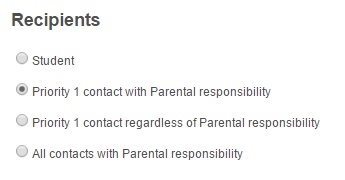 |
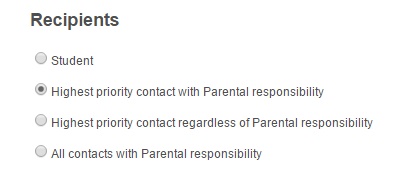
|
| With the preference on | With the preference off |
The right side of the page shows the methods that can be used to send messages. If a fallback method is selected, the second method of contact will only be used if the first is unavailable e.g. if "SMS falling back to Email" is selected, contacts will only receive an email if they do not have a valid SMS number.
Stage 2: Identify
The second tab will identify the contacts who are going to receive messages, and which method will be used to contact them.
Any students who cannot be contacted using the options selected will appear at the top of the list highlighted in red. Next to each student's name will be a list of contacts that PARS considered sending the message to. Each contact will have a number next to their name and may also have the letter "P". The number indicates the priority of the contact, and if the letter "P" is displayed then the contact has Parental Responsibility for that child.
There will also be icons next to each contact giving further information about how the contact is going to receive the message, or why they are not going to be contacted. The possible icons are:
| Icon | Meaning |
|---|---|
| File:Sms.jpg | The contact is going to receive an SMS |
| The contact is going to receive an email | |
| File:Letter.jpg | The contact is going to receive a letter |
| File:Warning.jpg | The contact will not receive a message because they either have a court order, or their priority level is too low |
| File:Spy.jpg | The contact will not receive a message because they do not have any valid contact details |
Stage 3: Documents
The next step is to choose the message that will be sent. There will be buttons to create a message for SMS, email or letter depending on how the messages are going to be sent.
When any of the buttons are clicked, a text editor will open to compose the message. free text can be entered into the editor, as well as mail merge fields or messages imported from the message bank.
Mail merge fields are inserted by clicking the "Insert" button and then "Field" - a list of the available merge fields will be displayed. Messages can also be imported from the message bank by clicking "Insert" then "Insert template". The drop-down at the top of the window is used to select different messages.
Finally, click the "Generate" button at the top right of the page to send your message!
Once the messages have been sent, a window will pop up. If any letters have been generated, a pop up window will appear with a "Collect" link which is used to download the letters as pdf documents for printing. If any pupils' contacts could not be reached (because they had missing or invalid contact details) a Report button will be visible which shows a summary of the pupils' contacts, and how they were contacted as well as those who could not be reached.
Recording phone calls and meetings
The external contact page can also be used to record the details of phone calls or meetings with parents. To do this, first select the pupil whose parents you are dealing with by clicking on the pupil's name on the left of the page.
The right side of the page will now show the pupil's contacts' details. Click the drop-down menu to choose between different contacts. Once you have chosen the contact, the right side of the page will show their details, so that you can find a phone number to ring.
If you have made a phone call home to parents then click the "Call" button on the right of the page. This will open a window where you can type the details of the phone call.
There is a "Contact type" drop-down that allows you to input extra information about the phone call. PARS will automatically record who made the phone call, which pupil it was about, which parent was spoken to and what time it took place, so the only information you need to record is what was said.
If you have dealt with parents not by phone, you can click the "Adhoc" button, which allows you to record the details of other contacts e.g. meetings.
Viewing contact history
If you click the "Contact history" button from the top toolbar you can view report that will show all of the communcations that have been made between the school and and a pupil's contacts.
